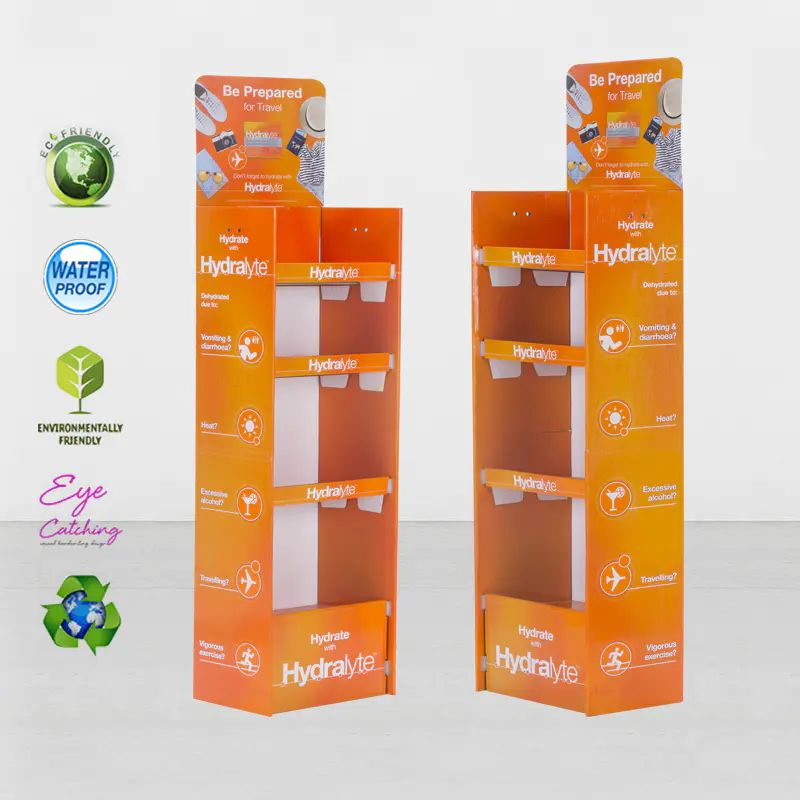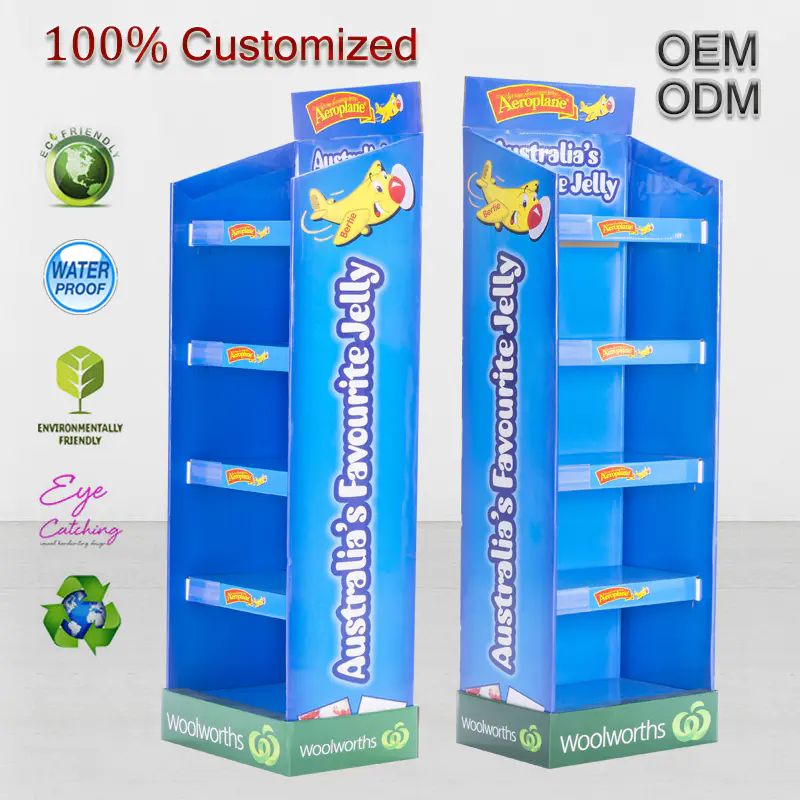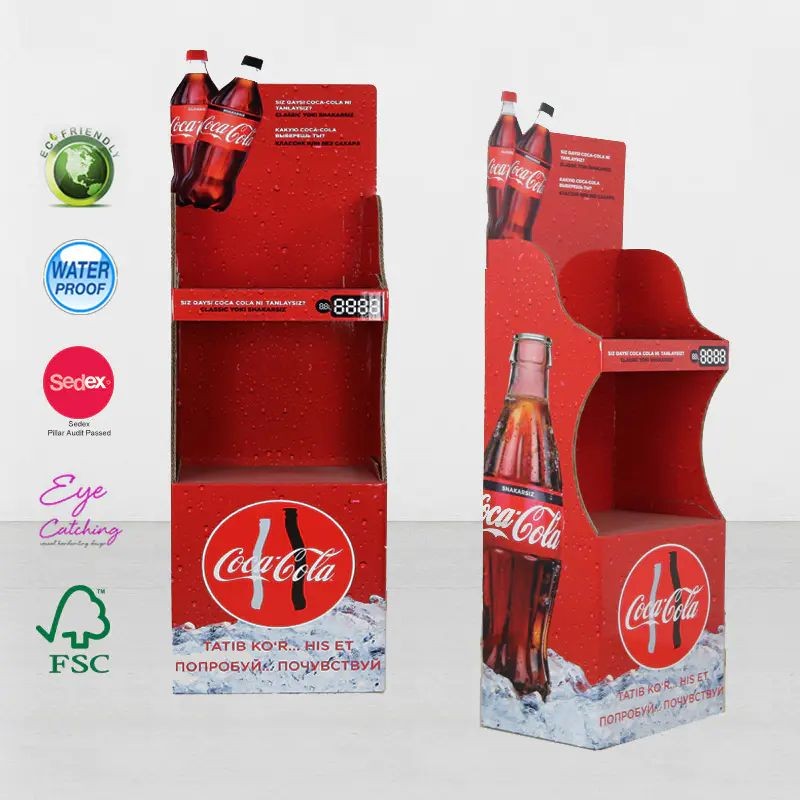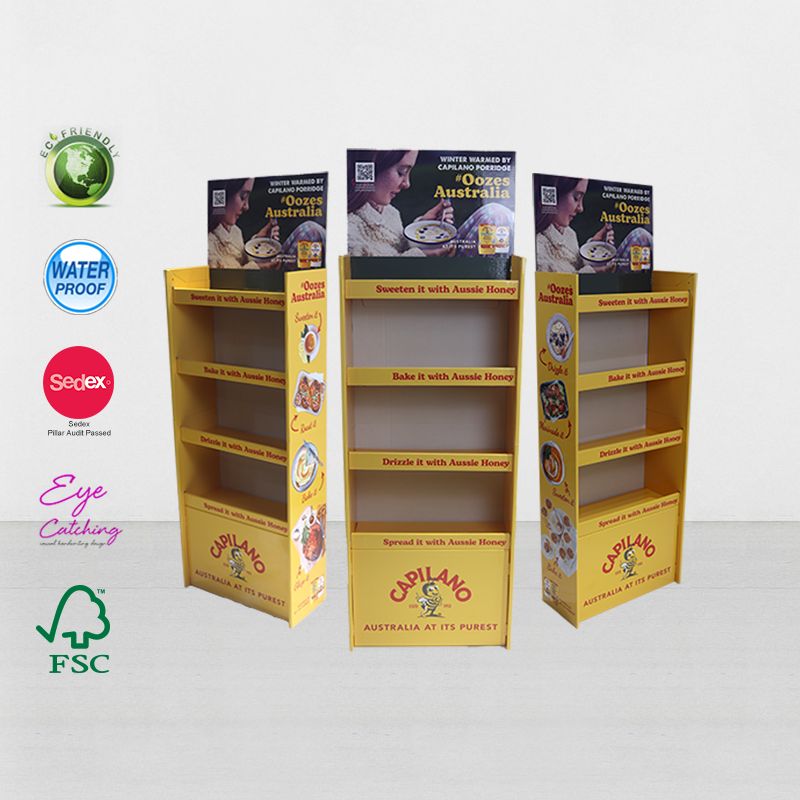In modern retail and exhibition industries, display stands play an irreplaceable role as essential tools for displaying and promoting products. With the growing popularity of environmental awareness and the demand for cost-effective displays, "freestanding cardboard displays" have gradually become a focus of market attention.
So, what exactly are freestanding cardboard displays? What are their unique features, functions, designs, materials, and application scenarios?
This article will systematically analyze all aspects of freestanding cardboard displays from a professional perspective, providing a comprehensive understanding for both practitioners and consumers.

What are freestanding cardboard displays?
Freestanding cardboard displays are made primarily of cardboard and can stand independently without attachment to a wall or other supporting structure. They are typically used for displaying products and promoting information, combining both display and marketing functions. Compared to traditional metal and wooden displays, freestanding cardboard displays are lighter, less expensive, and recyclable, making them widely used in retail, fast-moving consumer goods, promotional events, and exhibitions.
From a professional perspective, a freestanding cardboard display stand is more than just a simple stand; it's a comprehensive display tool. Its design must consider stability, load-bearing capacity, structural rationality, and aesthetics, while also being foldable, removable, and transportable. Therefore, a freestanding cardboard display stand is a comprehensive tool that combines functionality with marketing potential.
Freestanding Cardboard Display Stands: What are the Material Characteristics?
The core material of freestanding cardboard displays is cardboard. However, unlike ordinary cardboard, it is typically made of high-strength corrugated cardboard or composite cardboard. Corrugated cardboard offers lightweight, high strength, and excellent cushioning properties, allowing it to withstand the weight of merchandise while remaining lightweight. Composite cardboard, on the other hand, utilizes coatings, laminations, or reinforcements to enhance its durability and moisture resistance, ensuring the display stand remains stable over long-term use.
Furthermore, freestanding cardboard displays are often printed with environmentally friendly inks, integrating graphic and branding features. Because cardboard is easily recyclable, this type of display stand offers significant advantages in terms of environmental protection and sustainability, meeting the environmental requirements of modern businesses.
Material expertise is reflected in the following aspects:
• Thickness Selection: The thickness of the cardboard used in freestanding cardboard display stands directly affects its load-bearing capacity, generally ranging from 3mm to 10mm, and is designed based on the weight of the displayed merchandise.
• Corrugated Structure: Single, double, or specialty corrugated structures are used to ensure structural stability while minimizing material waste.
• Surface Treatment: The surface can be coated with a glossy film, matte film, or waterproof coating to improve moisture resistance and abrasion resistance while enhancing the visual effect.
• Printing Compatibility: The cardboard surface is suitable for digital printing, flexographic printing, or screen printing, meeting diverse brand display needs.

What are the design principles behind freestanding cardboard display stands?
The design of freestanding cardboard display stands is not simply a random stacking of cardboard; rather, it adheres to specific engineering and aesthetic principles. Its design typically includes the following core elements:
1. Structural Stability
Freestanding cardboard display stands must be self-supporting, meaning they can stand firmly without external support. This requires designers to achieve overall balance through appropriate fold lines, support panels, and base reinforcement. Structural designs typically employ triangular supports, staggered lamination, or interlocking structures to enhance load-bearing and compressive resistance.
2. Load-bearing and Safety
The weight of different products places varying demands on the load-bearing design of freestanding cardboard displays. Designers must calculate the number of cardboard layers, corrugated structure, and base dimensions based on the product weight to ensure the display does not tip or deform when displayed.
3. Space Utilization and Display Effect
When designing a freestanding cardboard display, rational space utilization must also be considered. For example, a multi-layer design can increase product display density, while a stepped structure facilitates visual observation and attracts customer attention. Branding information can be placed on the top or sides to enhance product and brand visibility.
4. Detachability and Transportability
Because retail and exhibition environments often require frequent movement and replacement, freestanding cardboard displays are often designed with a detachable or foldable design for ease of transportation, warehousing, and on-site assembly.
5. Visual and Marketing Design
The visual design of a freestanding cardboard display is crucial. Through color matching, pattern design, and brand logo placement, display stands not only display merchandise but also play a role in marketing communications. Designers need to comprehensively consider product positioning, brand style, and customer psychology when designing to achieve the best display effect.

What are the advantages of freestanding cardboard display stands?
Freestanding cardboard display stands are more than just a tool for displaying merchandise; they also offer a variety of functional features:
• Lightweight: Compared to metal or wooden display stands, cardboard is significantly lighter, making it easier to move and rearrange.
• Low Cost: Cardboard is relatively inexpensive, and the production process is simple, allowing for rapid mass production, reducing display costs for businesses.
• Environmentally Friendly: Cardboard is recyclable, meeting environmental standards and reducing carbon emissions during logistics.
• Highly Customizable: Freestanding cardboard display stands can be customized to suit product size, brand needs, and promotional themes, including the number of layers, size, shape, and printed content.
• Outstanding Marketing Function: By printing graphic information, freestanding cardboard display stands can enhance brand recognition, promote promotional information, attract customer attention, and increase purchase conversion rates.
• Adaptable to multiple scenarios: Whether in supermarkets, convenience stores, shopping malls, exhibitions, or promotional events, freestanding cardboard displays can be flexibly used to meet diverse display needs.
Freestanding Cardboard Displays: Application Scenarios
Freestanding cardboard displays are widely used in modern retail and exhibition industries, with applications including but not limited to the following:
1. Retail Display
Freestanding cardboard displays are commonly used in supermarkets, convenience stores, and shopping malls for new product promotions, limited-time sales, and brand showcases. Through strategic layout, they can attract customers' attention, increase product exposure, and boost sales.
2. Fast-Moving Consumer Goods Promotion
Fast-Moving consumer goods (FMCG) industries such as food, beverages, and cosmetics often use freestanding cardboard displays for promotional activities. Their lightweight, low-cost, and easy-to-print features make them an ideal choice for short-term and seasonal promotions.
3. Exhibitions and Events
At exhibitions or themed events, freestanding cardboard displays are used for product display, promotional messaging, and interactive experiences. Different designs can be tailored to the event theme, enhancing the display's impact and creating a sense of engagement.
4. Brand Promotion and Information Display
Businesses can use freestanding cardboard displays to showcase their brand philosophy, product features, and promotional information, achieving the dual effects of information dissemination and visual marketing.
5. Temporary Displays and Pop-up Stores
Freestanding cardboard displays are ideal for pop-up stores or temporary display locations due to their ease of assembly and disassembly, reducing operating costs while enhancing on-site display effectiveness.

Searching for a professional and low-cost cardboard display supplier?
Foshan Caiyijie Printing Co., Ltd. in China has 21 years of experience manufacturing high-quality retail displays. Our factory spans 20,000 square meters and includes 180 skilled employees. We offer a range of products: Floor Displays, Hook Displays, Sidekick Displays, Pallet Displays, PDQ Boxes, Dumpbins, Cutouts, and Large Packaging Boxes.
Using advanced digital proofing, printing, laminating, die-cutting, and automatic gluing equipment, we ensure structural stability, stylish designs, and premium finishing.

